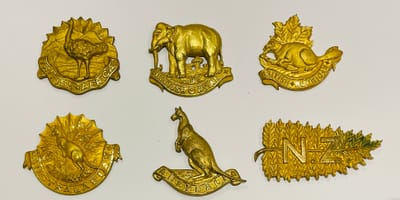Squadron Headdress and Collar Badges


Figure 196: Photograph of the Squadron badges of the King's Colonials. These are Officer's badges in gilt with the exception of the Australian Squadron kangaroo which is an Other Ranks badge in gilding metal.
The King’s Colonials group photograph (Figure 197) shows five different Squadron headdress badges being worn, many with matching pairs of collar badges.
Figure 197: A group of Officers and Other Ranks from all of the different Squadrons of the King’s Colonials Imperial Yeomanry showing the second pattern Forage Cap in khaki with a white cap cover circa 1906-07. The Officer, second from left in the middle row is denoted as a Field Officer as he bears gold braid to the peak of his forage cap. Captain Sir Hamar Greenwood (later Viscount Greenwood), ‘B’ Squadron (British American) is third from the left in the rear row holding a cane (Peter Nemaric collection).
From 1905, the first pattern Regimental collar badges worn by Other Ranks were replaced by Squadron collar badges of a similar pattern to the Squadron headdress badge. Officers continued to wear the second pattern Regimental collar badges.
The Squadron collar badges were worn as facing pairs with the heads of the Australian kangaroo, Asian elephant, Canadian beaver and African ostrich all facing inwards. The tips of the New Zealand Squadron fern leaf on their collar badges face outwards. The loops on genuine collar badges also lack broad feet. The one notable exception to the wearing of matching collar badges was the Australasian Squadron. Photographs of Troopers of ‘C’ Squadron (Australasian) do not show them to be wearing a collar badge modelled on the Australasian Squadron headdress badge (KK 1376). There has been no photographic evidence identified of Australasian collar badges being worn nor have any ever appeared on the market or in private or publicly available collections. Contemporary photographs show that the Australasian headdress badges were either worn without collar badges or with the first pattern Regimental inter-twined KC collar badges or with the later Australian Squadron collar badges.
In 1909, the term "Colony Squadrons" was abolished and consequently the wearing of Squadron headdress and collar badges was to be discontinued. All ranks were now to wear the smaller King’s Colonials second pattern Regimental headdress badge (KK 1371) on the bush-hat and the newly introduced khaki service dress cap with matching second pattern Regimental collar badges. I have seen no photographic evidence of these badges being adopted by all ranks. Squadron collar badges continued to be worn beyond the change of title of the Regiment from King’s Colonials to King Edward’s Horse in 1910. There are several photographs of members of the King Edward’s Horse wearing the former Squadron collar badges. Additionally, the King Edward’s Horse tunic shown in Figure 142 has a pair of the ‘C’ Squadron collar badges (KK 1376) with a King Edward’s Horse headdress badge as a NCO arm badge and KEH buttons.
The King’s Colonials Squadron headdress and collar badges are arguably among some of the most iconic and emblematic badges worn within the British Dominions. The choice of native animals as icons of the senior members of the Dominions was fitting as the members of the King’s Colonials were recruited from Dominion residents in Great Britain amidst the patriotic fervour evoked by the Second Boer War.


